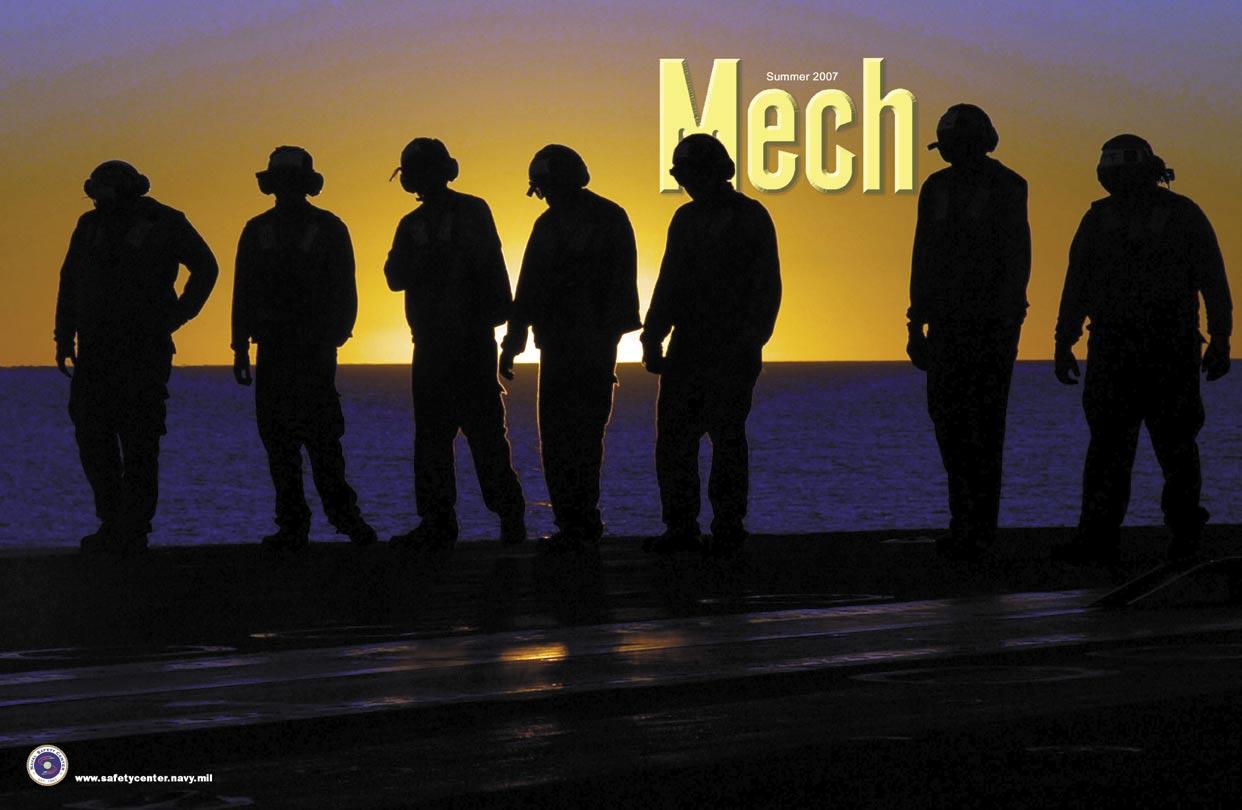
12 minute read
Crossfeed
Maintenance Officer
Cdr. Bert Ortiz bert.ortiz@navy.mil
Advertisement
Editorial Coordinator
ADCS(AW) Michael Tate
Airframes
Hydraulic Contamination Program Changes
By AMCS(AW) Robert Chenard
Problem: Not every command knows that NA 17-15E-52, Hydraulic Fluid Contamination Analysis Kit, was deleted in October 2006.
Solution: The contents of this manual were transferred to NA 01-1A-17, Aviation Hydraulics Manual. This change created more work packages in the dash 17 manual, so you need to make sure your people are up to speed and review this updated publication.
Highlights of the changes include: • NA 01-1A-17 is in work package format. • Increased from 14 sections to 17 work packages. • Description of hydraulic systems and fluids is in WP 003 00, vice section I, introduction. By AMCS(AW) Robert Chenard
Problem: We still find too many squadrons and commands with patch-test kits that are dirty, contain residual fluid, or have built up sludge and sediment.
Solution: We need to tighten up procedures. The Navy no longer has AMHs to specialize in hydraulics systems, so it’s up to all AMs who have the hydraulic contamination qualification to make sure hydraulic systems stay clean. Too often we find patch-test kits that are unsat. The electronic particle michael.tate@navy.mil
• WP 005 00, paragraph 26 contains information on the HACH Ultra Analytics Portable Oil Diagnostic System (PODS). You should note that the PODS eventually will replace the UCC CM20.9090 and the HIAC/ROYCO 8011-3, becoming the only particle counter for O and I level. • WP 017 00 is the patch-test kit (P/N 57L414), and it includes an illustrated parts breakdown.
Best Practice: Numerous commands are on board and have discovered the changes mentioned. They also have made sure program references, cross-reference locators sheets, and CTPL/DTPL are up to date. These steps show that they are on top of the game.
Senior Chief Chenard is a maintenance analyst at
Hydraulic Analysis Cleanliness Is Critical
the Naval Safety Center. counter (EPC) is the primary method, but sometimes you have to go “old school” and use a test kit. You must conduct periodic refresher training, using the test kit. The hydraulics manual, NA 01-1A-17, stresses the need to use proper sampling techniques and to use equipment and materials known to be clean to avoid foreign matter that can contaminate the sample fluid or testing equipment that can cause erroneous results.
If your system fails to meet the minimum standards (Class 5 for aircraft and Class 3 for SE), you must initiate a VIDS/MAF to decontaminate that system. Chapter six of this reference provides an excellent basic description of the various processes used. Read it. However, you also must look at your MIMs for specific details on your ECP bottle drain aircraft’s systems.
NA 01-1A-17 also says the EPC bottles “shall be cleaned only with hydraulic fluid.” If you use MILPRF-680 to clean them, it will cause a false contamination level. However, PRF-680 is the preferred solvent for cleaning patch-test bottles. Younger Sailors need to know the difference.
Best Practice: We’ve seen several squadrons using a locally manufactured draining rack to drain An Overview By AEC(AW/SW) Matthew Cooper
The Naval Safety Center provides a variety of services in an effort to raise fleet awareness and improve focus on a strong safety culture and readiness. Among our most successful and well-received services is the Maintenance Risk Management Presentation (MRM).
Naval Safety Center personnel provide this training upon request from individual commands. The MRM is a 60-minute program and uses a mix of PowerPoint slides, pictures, videos, and real-world experiences to emphasize concepts, practices, procedures, and pitfalls associated with aviation maintenance.
This presentation targets the “deck plate” maintainer and all maintenance managers. It is an outstanding tool that aids the recalibration of organizational culture. Included in this presentation are the concepts of operational risk management (ORM),
Patch test bottle drain
excess hydraulic fluid for EPC bottles and from patch-test bottles cleaned with PRF-680. It appears to work well; however, it’s necessary to have separate racks or to keep the bottles separate to prevent PRF-680 vapors away from the EPC bottles. Some commands cap them to prevent this problem.
Senior Chief Chenard is a maintenance analyst at
Maintenance Management
Maintenance Risk Management:
the Naval Safety Center. ground crew coordination (GCC), human factors (HFAC) and traffic-safety overviews. This presentation is best suited for large audiences, like aviation squadrons, organizational and intermediate level activities, air stations, aviation facilities, and detachments.
The MRM presentation is available to all interested units and is automatically scheduled in conjunction with an aviation safety survey team visit. Activities may request a presentation outside of this schedule, but those requests are considered on a case-by-case basis only. A request must be received at least three weeks in advance of the desired date. Contact the Aviation Directorate at (757) 444-3520 for more information or visit our website at http://www.safetycenter.navy.mil.
Chief Cooper is a maintenance analyst at the Naval Safety Center.
PPE
PPE: Will It Really Protect You?
By PRC(AW/SW) Brian Westcott
As I travel the globe and visit squadrons, AIMDs and MALs, I often notice that PPE is in poor condition and not always used correctly. This gear is designed to protect us from environmental hazards, and one of the most important pieces is the cranial.
How many times has your cranial been thrown in a cruise box or tossed across the room? We all know it happens. I also have seen problems with LOX coveralls, aprons, face shields, and gloves. This equipment is crucial to safety and mishap reduction. You can use ORM to mitigate the risks posed from poorly maintained PPE. 1. Identify the hazards: If a publication or other document states to wear PPE, you can be certain hazards exist, and your gear is the first line of defense. Make sure to look at all hazards in the work area. 2. Assess hazards: Look over your equipment. For cranials, make sure the back shell isn’t on upside down; it can cause neck and spinal injuries. Make sure spare lenses aren’t stored between the plastic back shell…it’s a FOD hazard. Check the ear pads to make sure they aren’t hard, brittle or sticky. They won’t work correctly if they’re in bad shape. Make sure the front and back shells aren’t cracked or missing pieces. You want the cranial to save your head and not create FOD. Check the reflective tape for the right size. Too much tape might hide cracked shells. Also look at the goggles for condition. For LOX, make sure aprons are used. I often find them folded and unused. Check LOX coveralls for frayed legs, dirt, or other conditions that make them unserviceable. Make sure face shields aren’t cracked or broken, and don’t wear LOX gloves that have holes or are dirty. 3. Make risk decisions: Make the decision to have and use serviceable PPE. One drop of LOX on your skin can leave a lifetime scar, and bad cranials can leave you injured or affect your hearing. Use the risk-assessment matrix, if needed, to identify a risk-assessment code. Then make a plan to reduce the hazards. 4. Implement controls: Take time to inspect PPE before using it. Replace worn equipment, and use proactive steps to enhance safety. 5. Supervise: Take care of your people, and make them take care of their PPE. Monitor each task, and stop maintenance when people aren’t wearing good, safe gear.
I ask that each of you start now. Take a look at your gear right after you’ve read this story. Make sure your PPE is working for you and doing its assigned job: keeping you safe.
Chief Westcott is a maintenance analyst at the Naval Safety Center.
Ordnance
By AOCS(AW/SW) Ron Carpenter
Ihave found that AA&E security, record-keeping, and personnel designations are inconsistent. In particular, I see recurring problems with appointing people to manage AA&E security/accountability programs, taking care of the control register, keeping records, conducting inventories, doing security surveys, and training.
The commanding officer must designate, in writing, an AA&E accountability officer and a key-and-lock custodian or access-control officer. These people assist the CO and make sure that security, access to ammo, and record-keeping is in accordance with current directives. For AA&E, OPNAVINST 5530.13C, is the instruction that mandates the requirements an activity must follow when AA&E is held within their spaces.
Squadron spaces and the ready-service locker must be designated as a restricted area when risk category AA&E is stored there. Typically, this ammunition is security-risk category three or four, and it is stated in the squadron’s security plan. The keys for the RSL are required to be stored in a separate key container from non-AA&E keys. That box must be made of 12-gauge steel and secured with an approved locking device. If a command has security-risk category 1 or 2 ammunition, the keys must be stored in a GSA-approved class 5 container.
The CO must appoint a person to do an annual security survey. These surveys must be retained for three years. Magazine key-and-lock inventories must be done semi-annually and retained for three years, too. Whenever a key-and-lock custodian is relieved, a 100-percent inventory of the ammunition and explosives must be completed.
I often find that the AA&E accountability officer and the key-and-lock custodian are the same person. The 5530.13C states that the duties of the key-and-lock custodian cannot be assigned to a person responsible for AA&E storage facilities.
Access lists must be maintained for people who have unescorted access to AA&E, and these lists
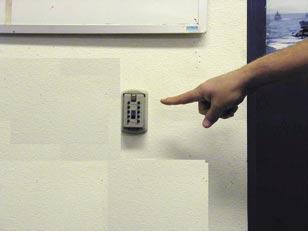
must be kept out of public view. Anyone with AA&E duties are required to have an annual screening, which is recorded on the record of screening. This form must be kept for six months after the person leaves the command.
The key-control register and the RSL access list provide continuous accountability of AA&E keys. The register must be filled out completely (all required elements or entries). The log is kept for three years after the date of the last entry.
Key chapters in the 5530.13C are Chapter 2 for risk categories, key security, storage requirements, key-control register requirements, and form retention times. Chapter 5 contains the duties and responsibilities of the AA&E accountability officer. Appendix F provides the AA&E physical-security checklist for forces ashore.
AA&E security is serious business. The procedures found in the 5530.13C must be followed to ensure ammo stays locked up. It doesn’t take a lot of explosives in the wrong hands to cause death, injury or damage.
Senior Chief Carpenter is an explosives and weapons-system analyst at the Naval Safety Center.
Technical Directives
Screening Logbooks for Technical Directives
By SSgt. Cristina McWilliams, USMC
Problem: Too many TD documentation problems are being found with logbooks when screened.
Solution: To eliminate this problem, you should make sure all the requirements outlined in the CNARFINST 4790.2, Vol V, Chapter 11 are being met. Squadrons cannot let operational pressure minimize the attention to detail given to a thorough screening of logbooks or to the necessary corrective actions needed to fix discrepancies found. I often find that the responsibilities listed in Volume V, Paragraph 11.3e are not being adequately completed. Commands must validate the incorporation of all applicable TDs using a current NA-500C. For any TDs that have exceeded compliance times because of reasons beyond the activity’s By ADCS(AW) Michael Tate
From February 15, 2007 to June 15, 2007, the Navy and Marine Corps had 46 Class C mishaps involving 46 aircraft. Dollar amounts still are being tallied, but, as of 15 June, it was over $2.9 million.
To say the least, this has been a bad quarter. We’re not sure of the reasons; maybe it was the start of the summer. Whatever the underlying causes, we must do better.
Most of the reports still are under investigation, so specific incidents can’t be discussed. However, a trend on the maintenance side is TFOAs and a new one, TFOS—things falling off ships.
We had several items that went swimming this quarter. We need to make sure that loose items are secured, so tie them down.
The same goes for TFOAs. Too many reports attribute the problem on corrosion or dirty surfaces. control, a waiver or deviation request must be submitted to the ACC/TYCOM via the chain of command. Volume V, Paragraph 11.3c says aircraft and equipment can’t be used if TDs are not incorporated within the required compliance time without that approval paperwork.
Consistent screening of the logbooks and the NA-500C is needed to prevent this serious problem.
Best Practice: MALS-31 at MCAS Beaufort, SC, had an excellent program. They regularly review required documents and have a checklist of all TDs. They use a screening sheet that ensures complete control over the TD process. It’s easy to use and very effective.
SSgt. McWilliams was a maintenance analyst at
Class C Mishap Summary
the Naval Safety Center. We have the planned maintenance system and 18- inch rule that should help prevent the senseless loss of items from the aircraft. We always try to blame a situation on material failure, rather than the reason the item failed. Too often, it’s poor PMS.
Analyze the situation; look for steps that would have prevented a TFOA, and fix maintenance practices to keep them from happening again. If we simply accept a TFOA as material failure without review, we’re doomed to repeat them.
Our day-to-day procedures need to be tightened up, and we need to get back to the basics. It’s the only steps that will help.
Senior Chief Tate is a maintenance analyst at the Naval Safety Center and coordinator of the Crossfeed section of Mech.
H otel Sierra Helping Sailors and Marines Help Themselves Sierra H otel
Commander, Naval Safety Center would like to recognize the following aviation commands for their recent participation in safety surveys, culture workshops, and maintenance malpractice resource management (MRM) presentations for the months of April-June.

Safety

HSL-47 HMLA-775 HMM-268 HMM-166 VAQ-133 VAQ-137
Surveys

NAWSC VFA-31 USS Wasp AIMD FRC NW (Whidbey Island) SFWSL, Oceana VP-1
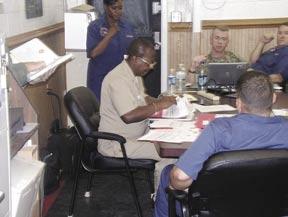
MRMs
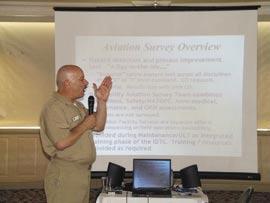
VR-53 AMO HMM-264 VPU-1


VR-62 VR-92 VP-26
Culture Workshops
VT-7 VT-3 VFC-111 VAQ-209 NASA Langley Navy Flight Demonstration Squadron VR-57 VAW-120 VP-40 MALS-42
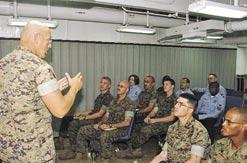
Navy photo by MC1 Michael Kennedy
For more information or to get on the schedule, please contact: Safety Surveys: Capt Chris Foley, USMC at 757-444-3520 Ext. 7223, MRM: AEC Matthew Cooper at 757-444-3520 Ext. 7275, Culture Workshop: Cdr. John Morrison at 757-444-3520 Ext. 7213.
